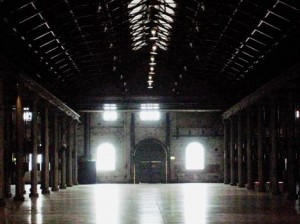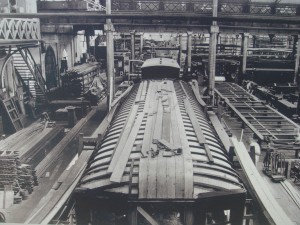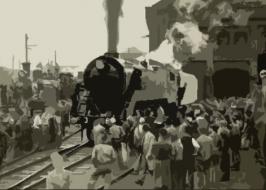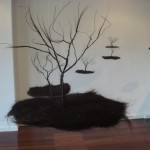Every day at one o’clock, a locomotive, heard but not seen, makes its way through the lobby of CarriageWorks, an old Sydney rail yard recently transformed into a performing arts center. The sound sculpture by Nigel Helyer, called GhosTrain, haunts the space it runs through. While the installation presented by Performance Space only sounds for 90 seconds, the complexities implied by the work encourage thoughtful engagement with the ideas of sound and history implied by its reference to acoustic ecology and the idea of a soundmark.

Architecturally, CarriageWorks has preserved the structures of the rail yard while creating new spaces within it to function as theatrical venues and offices. The building is a perfect symbiosis of old and new. However, to sound artist and sculptor Nigel Helyer, something was missing. Preserving the shells of human history, its buildings, leaves the social history of places unpreserved.
In working on GhosTrain, a multi-phase work, Helyer seeks to resurrect and preserve the more ephemeral life that once was in the building. In the first phase, the Sydney-based artist collected oral histories from former workers in the railyard in order to create audio portraits (listen to Station No. 1 for an idea of the train sounds used at CarriageWorks). In this second phase, he has created a site-specific audio installation that literally moves through the building, sound spills from one overhead speaker to the next.
Helyer will then, in the final phase, bring the first two phases together and create an interactive iPhone app that will be a “location sensitive augmented audio reality sonic-cartography,” as the artist describes it. Thus, the preserved building will be complemented by a resurrected audio history, the life that once was will again run through the building.

The sounds of a shunting train resonate in the space because of the history implied by that space. The sound is specific to a time and place; just like landmarks commemorate moments in a landscape, soundmarks also reference moments in history. Within the discipline of acoustic ecology created in the 1970s to record soundscapes being contaminated by sonic pollution, soundmarks were defined to be sounds highly evocative of a specific place. By capturing the ephemerality of sound through recording, Helyer manages to create an extremely powerful statement about the transience of social history.

As the last train whistle echoed through the once-again-silent building and the train disappeared back towards the quiet depths of the past, I felt a shiver down my spine. Helyer masterfully evoked an entire history while leaving much unspoken, unheard, and unseen. In a simple 90 seconds, my conviction of the power of sound as a medium unto itself was only reinforced. We often forget the ghosts that run through our historic buildings. For now at least, at CarriageWorks, whispers of the past have found a strong voice.
GhosTrain (also detailed on Australian Broadcasting Corporation Pool website) runs on time at 1 p.m. Monday through Saturday at Performance Space in the lobby of the CarriageWorks building in Sydney, Australia, until June 5.









